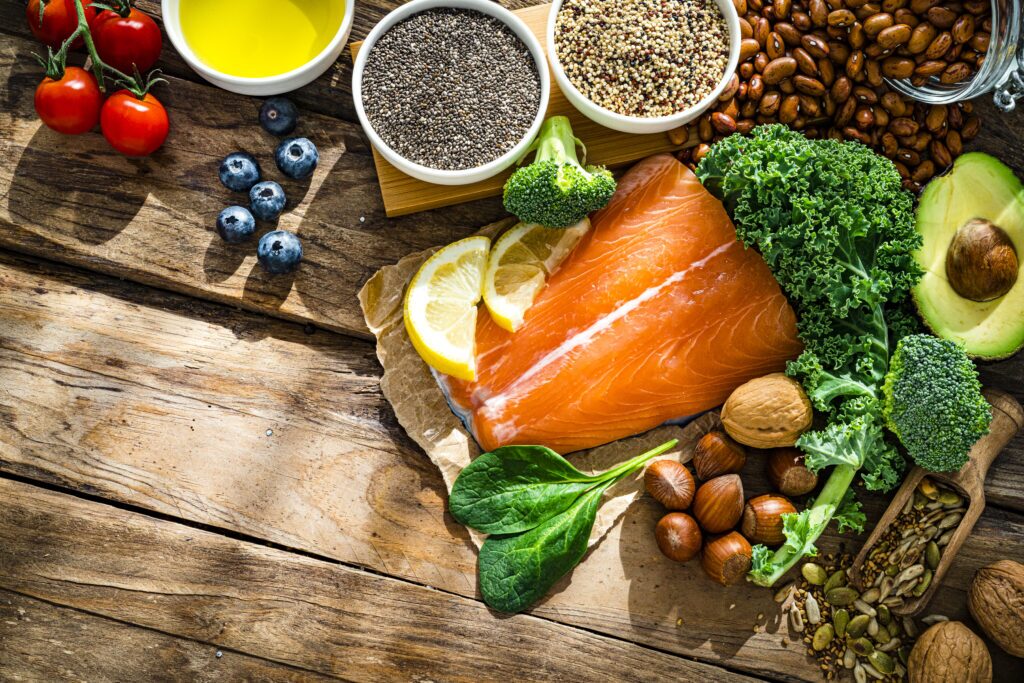Medical Review by DeAnna McGarity MD
Eat these foods to boost “Good” cholesterol & keep “bad” cholesterol at bay
Although the cholesterol you eat may not impact your risk of a heart attack directly, your diet still plays an important role in cholesterol management. Eating certain foods instead of others helps regulate the amount of cholesterol in your bloodstream, which improves cardiovascular health and lowers your risk of heart disease.
Below, we explain more about the link between what you eat and the cholesterol in your bloodstream—and recommend 10 foods that will help keep your cholesterol levels healthy.
The link between diet & cholesterol levels
The cholesterol you eat and the cholesterol that ends up in your bloodstream aren’t exactly the same. There are two main kinds of blood cholesterol: HDL (generally considered “good”) and LDL (sometimes called “bad” cholesterol).
- Helps move excess cholesterol from your blood to your liver. Takes excess bad fat or low-density lipoprotein (LDL) and takes it to the liver, where it’s broken down and leaves the body in stool. A high HDL level is likely to have a positive effect on a person’s risk of cardiovascular disease or lowers one’s risk of cardiovascular disease. This is often labeled as “good” or “healthy” cholesterol.
- Can lead to plaque buildup in your arteries, increasing your risk of heart disease. Transports the body from the liver to other parts of the body where it is stored. High LDL cholesterol levels are associated with a higher risk of cardiovascular disease and is often called “bad” or “unhealthy” cholesterol.
Eating foods that boost your HDL levels and avoiding foods that raise your LDL levels is therefore important for maintaining heart health. Not all foods with high dietary cholesterol significantly increase LDL levels, but many contain high levels of saturated or Trans saturated fats, which are linked to LDL buildup and associated heart problems.
See Also: 10 High Cholesterol Foods to Avoid
10 Recommended foods for managing cholesterol levels
Oats & whole grains
Oats and whole grains are a powerhouse for cholesterol management, thanks to their rich soluble fiber content.
How soluble fiber helps
- Acts like a sponge to absorb cholesterol in the digestive system
- This reduces the amount of cholesterol absorbed into the bloodstream
Ways to enjoy whole grains
- Try oatmeal for breakfast
- Use whole-grain bread for sandwiches
- Swap white rice with quinoa or brown rice
Fatty fish
Fatty fish, like salmon and mackerel, are high in omega-3 fatty acids, which are linked to maintaining healthy cholesterol levels.
How omega-3 fatty acids help
When you intake omega-3s daily, it can help lower triglycerides and lower types of blood cholesterol other than HDL (including your LDL levels).
Ways to enjoy fatty fish
- Eat fish that are rich in omega-3s
- Examples include salmon, herring, and mackerel
Nuts & seeds
Nuts and seeds are not only tasty snacks—they also add heart-healthy fats and fiber to your diet.
Ways to enjoy more nuts in your diet
- Add a handful to yogurt, salads, or enjoy as a heart-healthy snack
- Keep an eye on portions due to high-calorie content
Fruits & berries
Fruits and berries are loaded with antioxidants, making them excellent choices for a cholesterol-friendly diet.
How antioxidants impact your cholesterol levels
Antioxidants can help prevent cholesterol from oxidizing and creating a type of compound called an oxysterol. Since oxysterols can increase your risk of heart failure, antioxidants can help you avoid this possibility.
Ways to add fruit to your diet
- Incorporate a variety of fruits like apples, pears, and berries
- Try enjoying these on their own as snacks, or add them to smoothies
Vegetables
It’s common knowledge that vegetables are part of a healthy diet—but research suggests that eating a diet rich in low-calorie vegetables (as well as fruits and legumes) can lower your risk of heart attack, partially because the amount of dietary fiber they contain helps lower the LDL cholesterol in your blood.
Ways to eat more veggies
- Add leafy greens like spinach and kale to pasta and rice dishes
- Incorporate a variety of vegetables in salads and use dressings with monounsaturated fats (see below)
Beans & legumes
Beans and legumes have been shown to help lower total and LDL cholesterol levels. They have low fat, nearly no saturated fats, and low dietary cholesterol—while providing an excellent source of protein, carbohydrates, B vitamins, and other essential nutrients.
How protein supports healthy rating
Protein helps provide a feeling of fullness, which can reduce the temptation to snack on unhealthy treats. More protein also reduces body weight (BW), but also enhances body composition by decreasing fat mass while preserving fat-free mass (FFM)
Ways to enjoy more beans & legumes
- Easily add beans and legumes to soups and salads
- Try vegetarian dishes where beans and legumes fully replace animal proteins
Plant sterols & stanols
Foods rich in plant sterols and stanols can mimic cholesterol in the body, helping to lower LDL levels effectively.
Ways to eat more plant sterols & stanols
- Try cooking with vegetable oils
- Eat nuts
- Cook with vegetables like broccoli, spinach, and red onions
- Consider taking plant sterol supplements to lower your LDL cholesterol
Olive oil
Olive oil is rich in monounsaturated fats, known for their potential to lower bad cholesterol levels and maintain heart health.
Ways to use more olive oil
- Use it as the base for dressings and marinades
- Try using it to replace butter or other oils in cooking
Soy foods
Certain soy foods contain compounds that can reduce LDL cholesterol, as well as total cholesterol in adults.
Ways to incorporate soy foods into your diet
- Try tofu in stir-fries
- Use soy milk in cereals and smoothies
- Snack on edamame
Avocados
Avocados are not just delicious but also beneficial for cholesterol management, since they’re packed with heart-healthy monounsaturated fats just like olive oil.
Ways to eat more avocados
- Use them as a spread on whole-grain toast
- Add them to salads or sandwiches for a creamy texture
- Enjoy as guacamole with vegetable sticks
Extra advice for cholesterol control
Eating healthy is just one part of effective cholesterol management. We also recommend the following habits:
- Regular exercise: Try 30 minutes of walking, cycling, or swimming per day to keep your heart healthy by improving your ratio of HDL to LDL cholesterol.
- Weight management: Maintaining a healthy weight can help lower LDL cholesterol.
- Healthy lifestyle choices: Staying away from cigarettes can improve your HDL cholesterol.
- Drink plenty of water
- Discuss potential risks and benefits with your healthcare provider, a dietician and or nutritionist to find a diet or health plan for your needs.
- Some diets that are known to lower cholesterol; mediterranean, plant based, vegan and vegetarian.
Find support for managing your cholesterol with Lemonaid Health
Use the tips and food suggestions above to start making healthier choices right now—and be sure to contact a qualified healthcare provider before making any major diet or lifestyle changes.
Lemonaid Health can help—US-based medical team can provide online consultations and personalized treatment plans to help you manage your cholesterol levels, as well as lab work and prescriptions for appropriate cholesterol medications. Learn more about how we can provide you with the right support.












